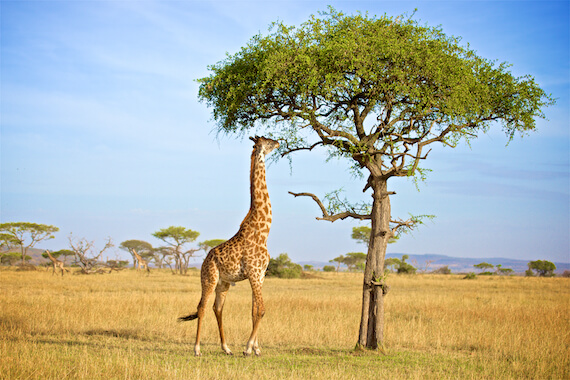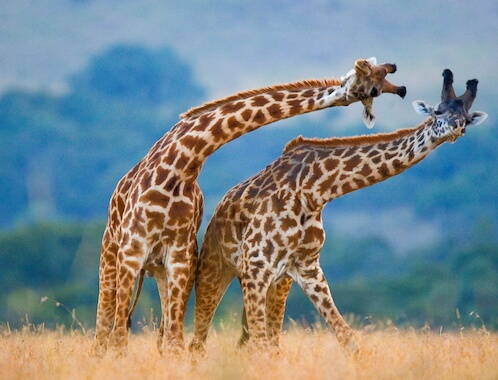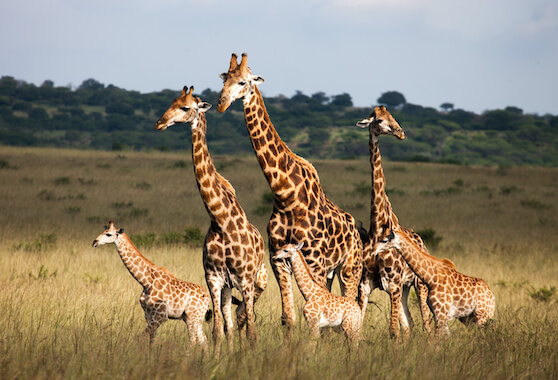
| Kingdom | Animalia |
| Phylum | Chordata |
| Class | Mammalia |
| Order | Artiodactyla |
| Family | Giraffidae |
| Genus | Giraffa |
| Species | Giraffa camelopardalis |
| Niche | Herbivorous browsing African mammal |
| Height | 14.1 – 19.3 feet (4.3 – 5.88 m) |
| Weight | 1,750 – 4,250 lb (794 – 1,930 kg) |
| Lifespan | 10 – 20 years |
| Social Structure | Herds |
| Conservation Status | Vulnerable |
| Preferred Habitat | Savannahs and open woodlands |
| Average Number of Offspring | 1 |
| Main Food Item | Twigs, shrubs, grass and fruit |
| Predators | Lions, crocodiles, leopards, hyenas and wild dogs |
The Basics
The giraffe is a herbivorous mammal native to the savannahs and open woodlands of Africa. It is the tallest extant terrestrial animal thanks to its long neck and is also the largest ruminant. There are currently nine recognized subspecies of giraffe, although it is currently under debate as to whether or not some of these should in fact be considered separate species.
Giraffes exhibit a distinctive coat pattern consisting of orange, brown or nearly black patches of fur separated by white or cream lines. Each individual giraffe has its own unique coat pattern, although certain coat pattern traits are inherited by calves from their mothers. Giraffes also have two short, horn-like structures on the top of their heads called ossicones, which are composed of ossified cartilage that is fused to the skull and covered in skin. Ossicones are vascularized, suggesting that they probably play a role in thermoregulation, however they are also used in fights between males.
Giraffes browse mainly on twigs, preferring the subfamily Acacieae and the genera Commiphora and Terminalia, which are high in calcium and protein to support their growth. In addition, giraffes feed on shrubs, grass and fruit, consuming around 75 lb (34 kg) of plant matter per day. Despite being herbivores, giraffes have also been known to lick dried meat off the bones of carcasses. Giraffes are ruminants, which means they acquire nutrients from their food via fermentation prior to digestion, a process that requires their food to be regurgitated and chewed again to break it down sufficiently.

Giraffes are known for their very long necks, which are typically around 6 feet (1.8 m) long and are thought to have evolved as a result of competition between African browsing herbivores for access to food. It has been hypothesized that giraffes with longer necks were selected for over time because they could reach food higher up in the trees, so didn’t have to compete with other browsers such as kudu and impala. In contrast, it has also been suggested that the giraffe’s neck evolved as a secondary sexual characteristic, with males that have longer, heavier necks having an advantage in so-called ‘necking’ contests over females.
Behavior and Reproduction
Giraffes congregate in herds that vary in size and composition according to ecological, social and temporal factors, but can number over 60 individuals. Herds are generally composed of only one sex, although mixed-sex groups of females and young males are known to occur. Females are more selective than males in which individuals they associate with and associations tend to be based on space-use and perhaps also on kinship. Whilst young males form groups and engage in play fights, they become more solitary as they mature. However, older males might still associate in pairs or with female groups.
Giraffes are polygamous, therefore older males mate with multiple females whilst younger males miss out. Males sometimes fight over females by engaging in a behavior called ‘necking’ in order to establish dominance. Low intensity necking involves two males rubbing their necks and leaning against each other, with the individual that is able to remain more upright winning the bout. Hight intensity necking is more aggressive and involves two males swinging their necks at each other and trying to hit their opponent with their ossicones. Whilst most fights don’t lead to injury, broken jaws, broken necks and even death can occur.

The gestation period for giraffes lasts 400 – 460 days, after which females give birth to a single calf, although twins do sometimes occur. Newborn giraffes are already 5.6 – 6.6 feet (1.7 – 2 m) tall and are able to stand up and run around after only a few hours. Nevertheless, newborns spend their first few weeks of life hiding from predators, relying on their coat pattern to provide camouflage. Calves suckle for variable lengths of time, ranging from one month up to a year. Similarly, the length of time that calves stay with their mother varies, but can last up until a new calf is born.
Fun Facts about Giraffes
The giraffe’s extraordinarily long neck is only one of many adaptations that provide examples of interesting biological concepts.
The Giraffe’s Neck
Giraffes exhibit a number of physiological adaptations that allow them to successfully survive with such long necks. Given that these animals are ruminants, their digestive systems must be capable of regurgitating food all the way back up the neck from the stomach to the mouth, a feat that is achieved by their unusually strong oesophageal muscles. Giraffes also have the longest recurrent laryngeal nerve of any living animal, which extends from the brain to the base of the neck and back up to the larynx. Individual cells in this nerve are almost 16 feet (5 m) long in the tallest giraffes.
The circulatory system in giraffes has also adapted to cater for their long necks. For example, in order to maintain blood flow to the brain, a giraffe’s heart must generate a blood pressure double that required in humans. To accomplish this, their hearts have walls as thick as 3 inches (7.5 cm) wide, are around 2 feet (6 m) long and can weigh more than 25 lb (11 kg). When giraffes bend their heads down, their circulatory systems must also prevent blood from rushing back down to the head, which is achieved in part by the many one-way valves in the jugular veins.
Cooperative Care of Young
Multiple female giraffes and their calves often gather in nursery herds, which move and eat together. These herds practice cooperative care of young, whereby a mother might leave her calf to be cared for by the herd whilst she forages or drinks elsewhere. This form of care is also seen in a number of other mammal species including lions, spotted hyenas and banded mongooses.

Caring for another individual’s offspring initially seems like a bad strategy for maximising reproductive success and fitness, thus it might be assumed that this strategy should be selected against. However, given that female giraffe herds are thought to be formed in part based on kinship, it is likely that females are caring for their relatives when practicing cooperative care. Therefore, they are still helping to propagate their genes indirectly, thus increasing their indirect fitness.
Species vs. Subspecies
It has traditionally been thought that one species of giraffe exists with nine subspecies, which can be distinguished by their different coat patterns. However, recent studies using genetic techniques suggest that between 2 and 6 of these subspecies should instead be classified as separate species. By comparing the DNA of different populations, scientists have found that certain giraffe subspecies have not interbred for a significant length of time, despite a lack of physical barriers to movement. This reproductive isolation is thought to be a result of giraffes only choosing mates with the same coat type as themselves and is driving speciation within the genus Giraffa.
The ability to study different populations at a genetic level has greatly improved our understanding of phylogenetic relationships both between and within taxa, which were traditionally determined using morphology alone. For example, a technique called DNA barcoding recently revealed that a presumed single species of skipper butterfly actually comprises 10 separate species that look almost identical as adults. Similarly, genetic techniques have finally been able to settle the debate over whether African savanna and forest-dwelling elephants are different species or not by confirming that they did indeed diverge into separate species between 2.6 and 5.6 million years ago.
